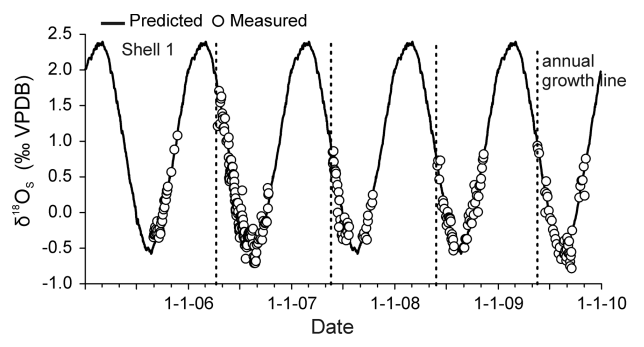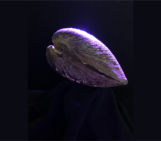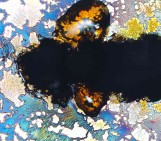Just as the rings on a tree can be used to determine its age, the bands on a bivalve’s shell can tell us the how long it’s been around for. Warm, food-filled waters lead to greater growth in the summer and low plankton abundance (the principle food source for filter-feeding molluscs) leads to limited growth during the winter months – hence the banding. But pinning down the age of a bivalve may not be a simple matter of counting bands as sudden changes in temperature and food availability throughout the year could cause multiple bands form within a single year.
This is where a little isotope geochemisty comes in. Oxygen naturally occurs as three sable isotopes: 16O, 17O and 18O and the ratio of these isotopes, particularly that of 18O/16O (known as δ 18O) reflects the temperature of the environment. Since 18O is heavier than 16O (by two neutrons), more energy is required to vaporise water containing 18O than 16O. So in the summer, when there’s more energy for evaporation, more water made up of 18O is evaporated and this leaves less 18O in the water (low δ 18O). The converse is true during winter, when there is little energy available for vaporisation and more water containing 16O is evaporated. In short, high δ 18O indicates low temperatures, and low δ 18O indicates high temperatures.
Since bivalves obtain the materials needed for their shells from the surrounding water, their oxygen isotope ratio reflects that of the water column. The seasonal cycling of δ 18O makes this a great way of verifying the bivalve’s age and checking whether we can trust the information gained from band-counting. This is what a team of geochemists led by Joana Cardoso set out to find: by counting the lines on a shell, can you get a reliable estimate of age?

This is a razor clam (Ensis directus). The white arrows point out the annual growth lines (click for larger). (Credit: Cardoso et al., 2013)
To start the investigation, you need to picture a line along the shell from the edge to the umbo (the most primitive part of the shell, where the two valves join). You can then take sections along this line and analyse the isotope ratios within them to see how δ 18O varies over time. The downside: as you approach the younger end of the shell, there is less and less carbonate available for sampling, to the point where there’s not enough material to do isotope analysis. Not to worry, you can combat this by pooling the carbonate sampled from neighbouring sections. Okay, so your data has slightly less resolution for the early stages of bivalve growth, but you can sample all parts of the shell – problem solved!
Cardoso’s results, published in Biogeosciences, found that δ 18O is an especially good measure of age and not only that, it matches the results you get for growth lines on both the inside and the outside of the shell!

Measured and predicted values for delta (δ) oxygen-18 in the shell. Carbonate is deposited in the summer and as the temperature rises, the ratio of oxygen-18 to oxygen-16 decreases, hence the troughs in measured delta oxygen-18 in the graph (white circles). (Credit: Cardoso et al., 2013)
The annual growth lines appear at the start of each growing season, in early summer. These coincide with the drop in δ 18O (remember this corresponds to a temperature rise). Carbonate that’s deposited from June to September (when there is most growth) provides the most detailed δ 18O data. The absence of data during the winter is because there is little or no growth – if no carbonate is deposited then there are no isotopes to analyse!
So, if you’re looking to age bivalves – count the rings – it’s still a sturdy method, and if you’re looking for more detailed data about both age and environmental conditions, oxygen isotope analysis is what you need.
By Sara Mynott, EGU Communications Officer
Reference:
Cardoso, J. F. M. F., Nieuwland, G., Witbaard, R., van der Veer, H. W., and Machado, J. P.: Growth increment periodicity in the shell of the razor clam Ensis directus using stable isotopes as a method to validate age, Biogeosciences, 10, 2013.


